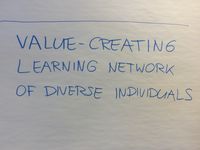Apart from our stakeholders and the core idea another topic I suggested at the Stoos…
Stoos Network (part 3): Core Idea
One wish I had for the gathering in Stoos was to discover a common foundation that could reconcile differences between the many management thinkers, writers and consultants the world has already generated before.
We have The Toyota Way, the 14 Points for Management, Radical Management, Management 3.0, Wiki-Management, Beyond Budgeting, Tribal Leadership, Servant Leadership, Elastic Leadership, the Declaration of Interdependence, and many more models, values and principles.
I asked the group at Stoos, “Is there something more fundamental?”
Is there a management axiom? Is there something that may be unproven, but yet so self-evident that we can all believe in it? Is there a core message that more or less implies everything else we think is true?
Value-Creating Networks
And so I suggested a late-night session about this topic in the bar of the hotel. For two hours roughly half of the Stoos group joined in an inspiring discussion about the best managed organizations in the world. What emerged was that most of the time we discussed organizations as networks instead of hierarchies. And this reminded me of the value networks I have described earlier on my blog.
I offered the group the suggestion to define organizations as value-generating networks. The group agreed, but decided to rename this to value-creating networks. The participants also agreed that hierarchies are not necessarily bad. There are many examples of well-functioning hierarchies within networks. They are basically a special case. (Though, regrettably, often badly applied.)
Learning, Diverse Individuals
At 1am in the night we agree we had achieved some convergence, but we also felt we had not finished yet. And so we continued the discussion, with a different subset of participants, the next day during open space. As the facilitator I started writing “value-creating networks” at the top of the flip chart, and I collected all kinds of suggestions that were candidates to be added to the core message. Not surprisingly, the participants came up with plenty of values and principles that we recognize from earlier management & leadership models, such as “visibility”, “trust”, “continuous improvement”, “develop people”, “courage”, etc…
I reminded the participants that our intention at this gathering was not to create the 57st management model, with yet another list of values and principles. There are already plenty of good ones. I said our hope is to unite good management thinkers and practitioners, not compete with them.
So we started a relentless analysis of the keywords that were offered. And in the end only three of those were moved to the top of the page:
- Individuals must be part of the core idea, because networks of machines or documents are not our main concern;
- Learning must be part of the core idea, because we don’t believe in organizations operating as machines with repeatable outcomes;
- Diversity could be part of the core idea, because we believe organizations with all too-similar people usually don’t work well.
This led to the following axiomatic view for managers:
Organizations are value-creating learning networks of diverse individuals
In our analysis, all other terms that were offered in our discussion turned out to be either logical prerequisites or consequences of the core belief. For example:
- Trust is necessary to create value in a network of people
- Continuous improvement directly ties into the learning network
- Sustainability means value-creation for certain stakeholders
- Self-organization is obviously the best approach in a network
- Feedback loops are required for learning
- Etc…
Learning Networks of People Creating Value
 This core belief of organizations as “value-creating learning networks of diverse individuals” was used as input for the communiqué that emerged at the end of the Stoos Gathering. We reordered the words for the sake of readability, “individuals” was replaced by “people”, and “diverse” didn’t survive the final review. And thus the final result became…
This core belief of organizations as “value-creating learning networks of diverse individuals” was used as input for the communiqué that emerged at the end of the Stoos Gathering. We reordered the words for the sake of readability, “individuals” was replaced by “people”, and “diverse” didn’t survive the final review. And thus the final result became…
learning networks of people creating value
Of course, there is plenty of ambiguity in this statement. For example, value to whom? Learning what? But that’s OK. We’ve only tried to identify the “What?” of organizational management. Many dozens of elaborate management models give you very useful answers to the subsequent “How?” question. And those usually depend on the context and the interpreter.
Complexity Made Simple
What I love most about this core idea is that it ties directly into complexity science. From science many experts have learned to recognize organizations as complex adaptive systems that try to survive. It seems our foundational message is nothing more (and nothing less) than the scientific view rewritten in common language. As Roy Osherove said, our version is simplicity science. It is less likely to scare stakeholders away.
And that was our purpose.
We hope smart management thinkers and practitioners can say, “Yes, that core message makes sense. And by the way, I have some good ideas on how to manage such a learning network of (diverse) people creating value.”
Tomorrow: Stoos Network (part 4): Name & Identity
Yesterday: Stoos Network (part 2): Stakeholders & Personas
For more information: Stoos Network website, Stoos Network group




